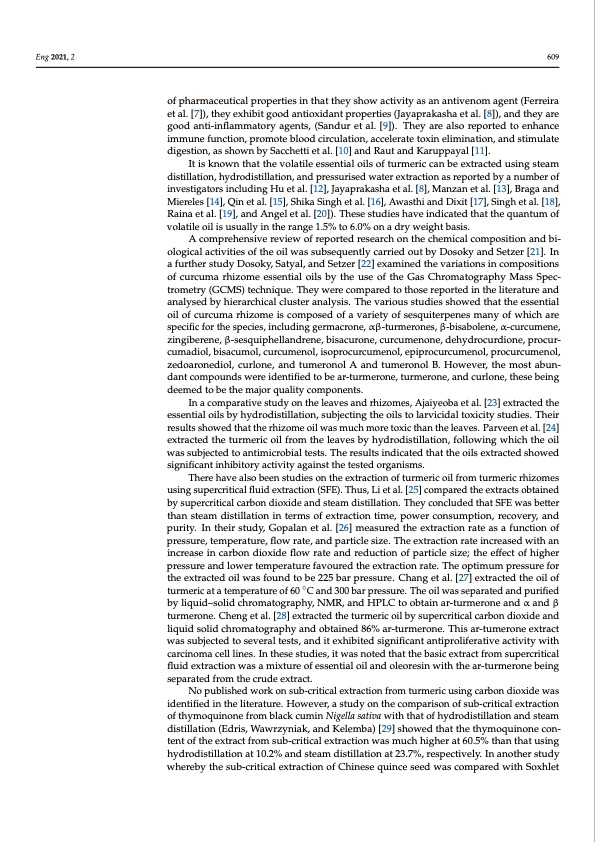
PDF Publication Title:
Text from PDF Page: 002
Eng 2021, 2 609 of pharmaceutical properties in that they show activity as an antivenom agent (Ferreira et al. [7]), they exhibit good antioxidant properties (Jayaprakasha et al. [8]), and they are good anti-inflammatory agents, (Sandur et al. [9]). They are also reported to enhance immune function, promote blood circulation, accelerate toxin elimination, and stimulate digestion, as shown by Sacchetti et al. [10] and Raut and Karuppayal [11]. It is known that the volatile essential oils of turmeric can be extracted using steam distillation, hydrodistillation, and pressurised water extraction as reported by a number of investigators including Hu et al. [12], Jayaprakasha et al. [8], Manzan et al. [13], Braga and Miereles [14], Qin et al. [15], Shika Singh et al. [16], Awasthi and Dixit [17], Singh et al. [18], Raina et al. [19], and Angel et al. [20]). These studies have indicated that the quantum of volatile oil is usually in the range 1.5% to 6.0% on a dry weight basis. A comprehensive review of reported research on the chemical composition and bi- ological activities of the oil was subsequently carried out by Dosoky and Setzer [21]. In a further study Dosoky, Satyal, and Setzer [22] examined the variations in compositions of curcuma rhizome essential oils by the use of the Gas Chromatography Mass Spec- trometry (GCMS) technique. They were compared to those reported in the literature and analysed by hierarchical cluster analysis. The various studies showed that the essential oil of curcuma rhizome is composed of a variety of sesquiterpenes many of which are specific for the species, including germacrone, αβ-turmerones, β-bisabolene, α-curcumene, zingiberene, β-sesquiphellandrene, bisacurone, curcumenone, dehydrocurdione, procur- cumadiol, bisacumol, curcumenol, isoprocurcumenol, epiprocurcumenol, procurcumenol, zedoaronediol, curlone, and tumeronol A and tumeronol B. However, the most abun- dant compounds were identified to be ar-turmerone, turmerone, and curlone, these being deemed to be the major quality components. In a comparative study on the leaves and rhizomes, Ajaiyeoba et al. [23] extracted the essential oils by hydrodistillation, subjecting the oils to larvicidal toxicity studies. Their results showed that the rhizome oil was much more toxic than the leaves. Parveen et al. [24] extracted the turmeric oil from the leaves by hydrodistillation, following which the oil was subjected to antimicrobial tests. The results indicated that the oils extracted showed significant inhibitory activity against the tested organisms. There have also been studies on the extraction of turmeric oil from turmeric rhizomes using supercritical fluid extraction (SFE). Thus, Li et al. [25] compared the extracts obtained by supercritical carbon dioxide and steam distillation. They concluded that SFE was better than steam distillation in terms of extraction time, power consumption, recovery, and purity. In their study, Gopalan et al. [26] measured the extraction rate as a function of pressure, temperature, flow rate, and particle size. The extraction rate increased with an increase in carbon dioxide flow rate and reduction of particle size; the effect of higher pressure and lower temperature favoured the extraction rate. The optimum pressure for the extracted oil was found to be 225 bar pressure. Chang et al. [27] extracted the oil of turmeric at a temperature of 60 ◦C and 300 bar pressure. The oil was separated and purified by liquid–solid chromatography, NMR, and HPLC to obtain ar-turmerone and α and β turmerone. Cheng et al. [28] extracted the turmeric oil by supercritical carbon dioxide and liquid solid chromatography and obtained 86% ar-turmerone. This ar-tumerone extract was subjected to several tests, and it exhibited significant antiproliferative activity with carcinoma cell lines. In these studies, it was noted that the basic extract from supercritical fluid extraction was a mixture of essential oil and oleoresin with the ar-turmerone being separated from the crude extract. No published work on sub-critical extraction from turmeric using carbon dioxide was identified in the literature. However, a study on the comparison of sub-critical extraction of thymoquinone from black cumin Nigella sativa with that of hydrodistillation and steam distillation (Edris, Wawrzyniak, and Kelemba) [29] showed that the thymoquinone con- tent of the extract from sub-critical extraction was much higher at 60.5% than that using hydrodistillation at 10.2% and steam distillation at 23.7%, respectively. In another study whereby the sub-critical extraction of Chinese quince seed was compared with SoxhletPDF Image | Sub-Critical Fluid Extraction Turmeric vs Hydrodistillation

PDF Search Title:
Sub-Critical Fluid Extraction Turmeric vs HydrodistillationOriginal File Name Searched:
eng-02-00038.pdfDIY PDF Search: Google It | Yahoo | Bing
CO2 Organic Rankine Cycle Experimenter Platform The supercritical CO2 phase change system is both a heat pump and organic rankine cycle which can be used for those purposes and as a supercritical extractor for advanced subcritical and supercritical extraction technology. Uses include producing nanoparticles, precious metal CO2 extraction, lithium battery recycling, and other applications... More Info
Heat Pumps CO2 ORC Heat Pump System Platform More Info
| CONTACT TEL: 608-238-6001 Email: greg@infinityturbine.com | RSS | AMP |